Categories
WITH EXPERIENCE, COMES EXPERTISE
We have unique experience in buying, trading and selling estate jewellery. We have hundreds of previously owned items such as: diamond rings, gold coins, bracelets, earrings, pendants etc. Call or visit our store if there is a particular item you are looking for.
November 21, 2025
Art-Deco 1920s filigree diamond ring, 0.33ct. European cut, 1.8gr. 14kt. gold. $1,020.00 CAD. 101-00485
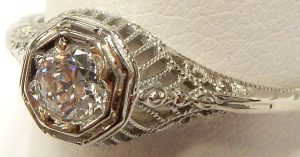 We never grow tired of showcasing these beautiful antique diamond engagement rings from the early part of the 20th century. They have an almost universal appeal to everyone. There is no denying the artistry of the jewellers who made these wonderful rings 100 years ago. They are becoming more scarce all the time as they are worn by successive generations adding wear and tear these rings weren’t designed for. Rings like these were considered exceptionally precious works of art, worn carefully and consciously. They were not intended to be worn while doing heavy physical activity. They are built durably but with limits.
We never grow tired of showcasing these beautiful antique diamond engagement rings from the early part of the 20th century. They have an almost universal appeal to everyone. There is no denying the artistry of the jewellers who made these wonderful rings 100 years ago. They are becoming more scarce all the time as they are worn by successive generations adding wear and tear these rings weren’t designed for. Rings like these were considered exceptionally precious works of art, worn carefully and consciously. They were not intended to be worn while doing heavy physical activity. They are built durably but with limits. The delicate shank on this example only measures just under 1mm wide, it wouldn’t have been any thicker than 1.5mm even when it was brand new. One trip to the gym today with this ring on would likely result in a bent or broken shank. Rings like this can be worn often but they must be treated cautiously. The fine pierced filigree galleries on this ring are practically perfect, they still feature fine milgrain and engraving that is still very crisp and sharp.
The delicate shank on this example only measures just under 1mm wide, it wouldn’t have been any thicker than 1.5mm even when it was brand new. One trip to the gym today with this ring on would likely result in a bent or broken shank. Rings like this can be worn often but they must be treated cautiously. The fine pierced filigree galleries on this ring are practically perfect, they still feature fine milgrain and engraving that is still very crisp and sharp. The diamond in this ring measures 4.50mm x 2.65mm and is estimated to weigh 0.33 carat. Compared to the monster 2.00 to 5.00 carat lab-grown monsters we’re selling these days it looks rather small, but this size of natural diamond was available to only those with significant means back then. Most young brides only wore a simple wedding band. Having a diamond (of any size) was uncommon, and this one is much larger than what we usually see in these styles. It is of very nice SI1 clarity with a GH colour. There is little chance this diamond came from anywhere other than South Africa as that was pretty much the only source for diamonds back then. This ring measures a larger than average size 10.
The diamond in this ring measures 4.50mm x 2.65mm and is estimated to weigh 0.33 carat. Compared to the monster 2.00 to 5.00 carat lab-grown monsters we’re selling these days it looks rather small, but this size of natural diamond was available to only those with significant means back then. Most young brides only wore a simple wedding band. Having a diamond (of any size) was uncommon, and this one is much larger than what we usually see in these styles. It is of very nice SI1 clarity with a GH colour. There is little chance this diamond came from anywhere other than South Africa as that was pretty much the only source for diamonds back then. This ring measures a larger than average size 10.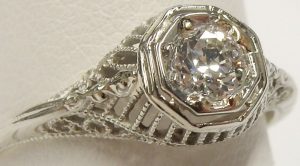 We can adjust it down 2 or 3 sizes if needed. There is no reason to believe this ring will not last many more decades if looked after and worn carefully. It is light at only 1.8 grams and a pleasure to wear. This style of ring always receives compliments from our customers and don’t last in our showcases very long. If you’ve always admired the Art-Deco design period, here is a great chance to get a classic example at the estate price of $1,020.00 CAD. Stock #101-00485.
We can adjust it down 2 or 3 sizes if needed. There is no reason to believe this ring will not last many more decades if looked after and worn carefully. It is light at only 1.8 grams and a pleasure to wear. This style of ring always receives compliments from our customers and don’t last in our showcases very long. If you’ve always admired the Art-Deco design period, here is a great chance to get a classic example at the estate price of $1,020.00 CAD. Stock #101-00485.
SOLD
November 20, 2025
Early 1980s, must de Cartier, sterling silver vermeil, hand wind, 20.5mm. $2,500.00 CAD. 501-00403
 The “must de Cartier” line of watches is back and they have been popular with those looking for an understated form of classic timekeeping. The reintroduction in 2021 was a huge success and quickly sold out the initial production run. The “Tank” design has been around since 1917 and has been a cornerstone of the Cartier style ever since. In the 1970s Cartier was looking to rejuvenate their brand as sales were not what they once were. The post World War II economic boom produced a large demographic of a new middle class who couldn’t necessarily afford Cartier’s traditional ultra luxury offerings, but they could afford something better than basic timekeeping.
The “must de Cartier” line of watches is back and they have been popular with those looking for an understated form of classic timekeeping. The reintroduction in 2021 was a huge success and quickly sold out the initial production run. The “Tank” design has been around since 1917 and has been a cornerstone of the Cartier style ever since. In the 1970s Cartier was looking to rejuvenate their brand as sales were not what they once were. The post World War II economic boom produced a large demographic of a new middle class who couldn’t necessarily afford Cartier’s traditional ultra luxury offerings, but they could afford something better than basic timekeeping. The introduction of must de Cartier in the late 1970s couldn’t have been better timed. They were crafted from sterling silver covered with 20 microns of hard gold plating and featured new technology battery operated electronic quartz mechanisms along with traditional hand wind movements. The must de Cartier was an upscale alternative to the onslaught of less expensive, excellent quality, quartz watches from Japan. This estate Cartier is one of the more desirable hand wind examples; powered by the small but reliable 17 jewel calibre 78-1.
The introduction of must de Cartier in the late 1970s couldn’t have been better timed. They were crafted from sterling silver covered with 20 microns of hard gold plating and featured new technology battery operated electronic quartz mechanisms along with traditional hand wind movements. The must de Cartier was an upscale alternative to the onslaught of less expensive, excellent quality, quartz watches from Japan. This estate Cartier is one of the more desirable hand wind examples; powered by the small but reliable 17 jewel calibre 78-1.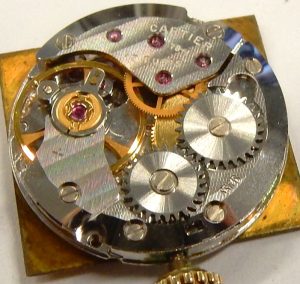 So reliable in fact that is has never been serviced, still runs and keeps good time. The gold plated case is in very good condition and completely original. The 20 micron gold plated sterling silver case shows some scuffs and small dings but is fully intact. After more than four decades of use, most of these watches display areas of significant sterling silver showing through the gold plating. This is most commonly seen around the lug corners and top edges. The four top corners on this watch display a tiny amount of silver through the gold plate. This is a survivor example, original protective sticker is still in place on the back after more than 40 years.
So reliable in fact that is has never been serviced, still runs and keeps good time. The gold plated case is in very good condition and completely original. The 20 micron gold plated sterling silver case shows some scuffs and small dings but is fully intact. After more than four decades of use, most of these watches display areas of significant sterling silver showing through the gold plating. This is most commonly seen around the lug corners and top edges. The four top corners on this watch display a tiny amount of silver through the gold plate. This is a survivor example, original protective sticker is still in place on the back after more than 40 years. It looks like it has never even been serviced before. The case back has no service records etched inside.
It looks like it has never even been serviced before. The case back has no service records etched inside.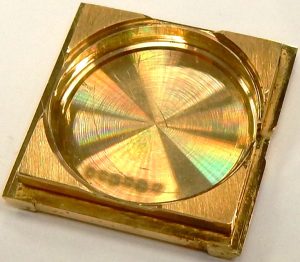 It even sports the Cartier buckle but the leather strap in not the original.
It even sports the Cartier buckle but the leather strap in not the original. The retro tri-colour gold mirror dial is perfect, not a single stain or blemish of any kind.
The retro tri-colour gold mirror dial is perfect, not a single stain or blemish of any kind.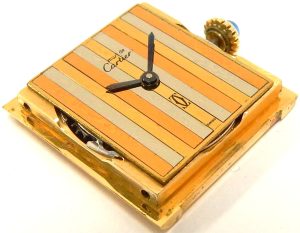 Likewise can be said of the blued steel hands, case screws, and blue spinel knurled crown. The low domed glass crystal shows only microscopic scuffs and nicks on the edges. It comes with original documents in folder but no warranty card.
Likewise can be said of the blued steel hands, case screws, and blue spinel knurled crown. The low domed glass crystal shows only microscopic scuffs and nicks on the edges. It comes with original documents in folder but no warranty card.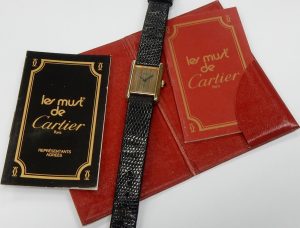 We’ve elected to leave this watch in as presented condition, complete with oxidation on the gold plating that can easily be removed if you choose to.
We’ve elected to leave this watch in as presented condition, complete with oxidation on the gold plating that can easily be removed if you choose to. It’s running well and keeping good time despite having never been serviced. We will include a full technical revision of the movement along with a new strap for the next owner. This classically proportioned vintage Cartier measures 20.5mm wide (excluding the crown) and 28mm long lug to lug.
It’s running well and keeping good time despite having never been serviced. We will include a full technical revision of the movement along with a new strap for the next owner. This classically proportioned vintage Cartier measures 20.5mm wide (excluding the crown) and 28mm long lug to lug. The new versions of these classics are now made from stainless steel, no more gold plated sterling silver, and no more manual wind movements, all of the smaller ladies models are now powered by quartz movements. Cartier further simplified the design by eliminating everything from the dial except the logo. The price point for the new versions start at $4,850.00 in stainless steel. Including our 1-year warranty it is estate priced at $2,500.00 CAD. Stock #501-00403.
The new versions of these classics are now made from stainless steel, no more gold plated sterling silver, and no more manual wind movements, all of the smaller ladies models are now powered by quartz movements. Cartier further simplified the design by eliminating everything from the dial except the logo. The price point for the new versions start at $4,850.00 in stainless steel. Including our 1-year warranty it is estate priced at $2,500.00 CAD. Stock #501-00403.
November 19, 2025
Antique diamond solitaire 0.065ct. SI-H, 1.9 grams, size 9. $510.00 CAD. 101-00489
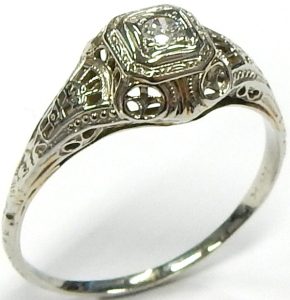 If you were married 100 years ago and you had a few extra dollars, you may have been able to afford a thin gold wedding band. The engagement ring was still a relatively new concept, diamonds were rare and expensive, a stone of 1 carat or more were almost never seen except in the big cities where a few wealthy people had them. Today we can sell you a 2 carat, perfectly cut lab-grown diamond of top quality (VVS2-F or better) for just $660.00 USD.
If you were married 100 years ago and you had a few extra dollars, you may have been able to afford a thin gold wedding band. The engagement ring was still a relatively new concept, diamonds were rare and expensive, a stone of 1 carat or more were almost never seen except in the big cities where a few wealthy people had them. Today we can sell you a 2 carat, perfectly cut lab-grown diamond of top quality (VVS2-F or better) for just $660.00 USD.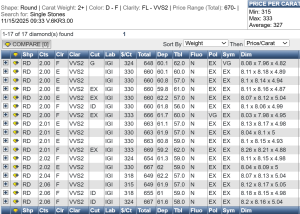 This antique estate diamond engagement ring is typical of what a fortunate bride might be wearing in the 1920-1930s. Light, delicate, with intricate details were the standard back then rather than the exception.
This antique estate diamond engagement ring is typical of what a fortunate bride might be wearing in the 1920-1930s. Light, delicate, with intricate details were the standard back then rather than the exception. 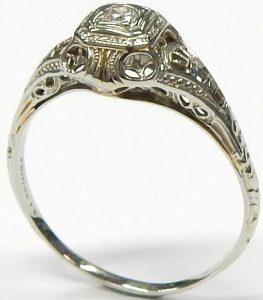 High quality with superb craftsman were what to expect even in a light weight ring like this. Many rings from this era survived the first and perhaps some of the second generation but seldom do they come to us in this sort of condition. The pierced filigree on the shoulders and gallery is in very good condition showing only minor wear. The fine milgrain detail is still quite sharp given it is 100 years old.
High quality with superb craftsman were what to expect even in a light weight ring like this. Many rings from this era survived the first and perhaps some of the second generation but seldom do they come to us in this sort of condition. The pierced filigree on the shoulders and gallery is in very good condition showing only minor wear. The fine milgrain detail is still quite sharp given it is 100 years old. It’s quite light at just over 1.9 grams but premium 18 karat white gold alloys from this era are much more resilient than you’d expect. The size 9 ring has a thin shank but is safe to wear as long as you don’t do heavy physical work when it’s worn. Adjusting it down a size or two wouldn’t be problem and will increase the strength. The round transition brilliant cut diamond is a modest 0.065 carat of nice SI-GH quality.
It’s quite light at just over 1.9 grams but premium 18 karat white gold alloys from this era are much more resilient than you’d expect. The size 9 ring has a thin shank but is safe to wear as long as you don’t do heavy physical work when it’s worn. Adjusting it down a size or two wouldn’t be problem and will increase the strength. The round transition brilliant cut diamond is a modest 0.065 carat of nice SI-GH quality.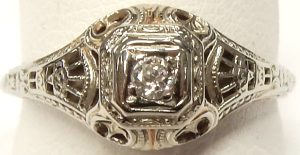 It is secured by the original bead claws than don’t appear to have ever been rebuilt. These Art-Deco engagement ring are always well received by our customers, especially when they are original and in very good condition. This antique diamond ring is estate priced at $510.00 CAD. Stock #101-00489.
It is secured by the original bead claws than don’t appear to have ever been rebuilt. These Art-Deco engagement ring are always well received by our customers, especially when they are original and in very good condition. This antique diamond ring is estate priced at $510.00 CAD. Stock #101-00489.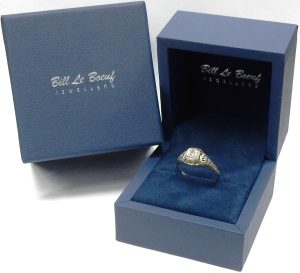
November 18, 2025
1970s Heuer Daytona 110.203B calibre 12 automatic 39.5mm. $5,500.00 CAD. 520-00166
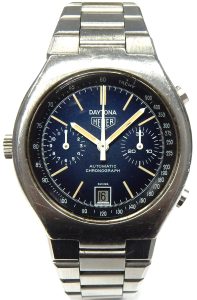 Vintage chronographs have always had a market, the nostalgic look, feel, and sound of a mechanical stopwatch can’t be duplicated. The 1970s were the heyday for mechanical watches. The 1980s ushered in a flood of inexpensive electronic battery powered that almost put the Swiss watchmaking industry out of business.
Vintage chronographs have always had a market, the nostalgic look, feel, and sound of a mechanical stopwatch can’t be duplicated. The 1970s were the heyday for mechanical watches. The 1980s ushered in a flood of inexpensive electronic battery powered that almost put the Swiss watchmaking industry out of business. Heuer were at the top of their creative game in the 60s and 70s with the iconic Carrera, Autavia, and Monaco watches. Heuer kept the funky shaped case theme going with the introduction of the Daytona around 1976. This rare model was only made for around 5 years. This is the first one to ever show up in our estate collection. The blue vignette dial on our example is perfect.
Heuer were at the top of their creative game in the 60s and 70s with the iconic Carrera, Autavia, and Monaco watches. Heuer kept the funky shaped case theme going with the introduction of the Daytona around 1976. This rare model was only made for around 5 years. This is the first one to ever show up in our estate collection. The blue vignette dial on our example is perfect.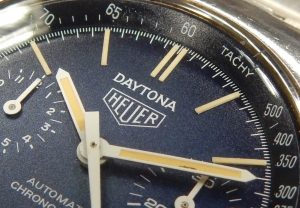 There isn’t a stain or scuff anywhere to be seen (even under magnification). The lighter blue centre section grows gradually darker toward the edges, culminating in a navy blue tachymeter scale on the sloped chapter ring. Powering the Daytona is the Heuer left hand crown, 17 jewel calibre 12. This is a significant mechanism in the world of horology and was an updated version of the famous calibre 11. The calibre 11 debuted in early 1969 with the goal of being the world’s first automatic winding watch with a chronograph. The calibre 12 addressed a few of the shortcomings points of the 11. Some parts were strengthened while a few others were made a little more compliant, resulting in added durability and reliability.
There isn’t a stain or scuff anywhere to be seen (even under magnification). The lighter blue centre section grows gradually darker toward the edges, culminating in a navy blue tachymeter scale on the sloped chapter ring. Powering the Daytona is the Heuer left hand crown, 17 jewel calibre 12. This is a significant mechanism in the world of horology and was an updated version of the famous calibre 11. The calibre 11 debuted in early 1969 with the goal of being the world’s first automatic winding watch with a chronograph. The calibre 12 addressed a few of the shortcomings points of the 11. Some parts were strengthened while a few others were made a little more compliant, resulting in added durability and reliability.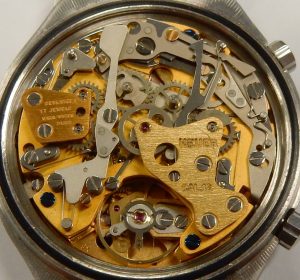 The frequency of the improved calibre 12 was increased to 21,600 for better accuracy. The Daytona was one of the last models to use the calibre 12, it was retired in 1980 along with the Daytona. The name is a tribute the to famous Florida racetrack and specifically the 24-hour endurance race that is still happens every year at the end of January. A relatively common, nice quality Rolex Daytona from the mid to late 1970s is going run you close to $100,000 these days. This much rarer Heuer Daytona is only around 1/20th of the Rolex cost. A Heuer Daytona also has the extra convenience of automatic winding, plus a handy 31 calendar adds further utility.
The frequency of the improved calibre 12 was increased to 21,600 for better accuracy. The Daytona was one of the last models to use the calibre 12, it was retired in 1980 along with the Daytona. The name is a tribute the to famous Florida racetrack and specifically the 24-hour endurance race that is still happens every year at the end of January. A relatively common, nice quality Rolex Daytona from the mid to late 1970s is going run you close to $100,000 these days. This much rarer Heuer Daytona is only around 1/20th of the Rolex cost. A Heuer Daytona also has the extra convenience of automatic winding, plus a handy 31 calendar adds further utility.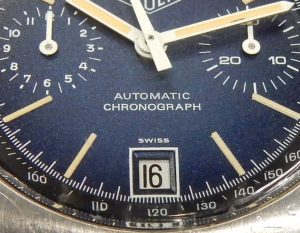 This example is in remarkable condition. As mentioned, the dial is perfect, with tritium hour markers and hands showing even tan patina. The luminous tritium no longer glows and shows only minor separation on the minute hand. When we opened the watch for inspection we were surprised to see just one record of service.
This example is in remarkable condition. As mentioned, the dial is perfect, with tritium hour markers and hands showing even tan patina. The luminous tritium no longer glows and shows only minor separation on the minute hand. When we opened the watch for inspection we were surprised to see just one record of service.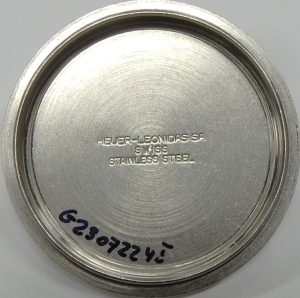 At close to 50 years old we would expect to see 3 or 4 additional service etching inside the threaded case back. This would suggest the watch hasn’t been worn very much or has sat idle for decades. That explains the excellent overall condition. The bracelet shows little wear or stretch, still displaying sharp crisp bevelled edges.
At close to 50 years old we would expect to see 3 or 4 additional service etching inside the threaded case back. This would suggest the watch hasn’t been worn very much or has sat idle for decades. That explains the excellent overall condition. The bracelet shows little wear or stretch, still displaying sharp crisp bevelled edges. The original fluted pushers and knurled crown are fully functional with good action.
The original fluted pushers and knurled crown are fully functional with good action.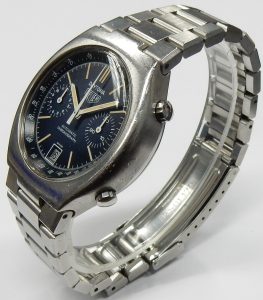
 Even the original horizontally signed Heuer buckle is here and snaps tightly shut with a reassuring click.
Even the original horizontally signed Heuer buckle is here and snaps tightly shut with a reassuring click.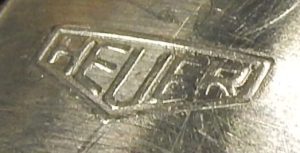
 Over the years with continuous wear the factory engraved style/serial numbers often completely disappear, not so with this one, the machined etchings numbers are still clearly visible on the edge of the case back.
Over the years with continuous wear the factory engraved style/serial numbers often completely disappear, not so with this one, the machined etchings numbers are still clearly visible on the edge of the case back. Overall, this is a very good example of a rare and underappreciated Heuer. We a happy to offer the next owner a complimentary 1-year warranty. This retro classic is estate priced at $5,500.00 CAD. 520-00166.
Overall, this is a very good example of a rare and underappreciated Heuer. We a happy to offer the next owner a complimentary 1-year warranty. This retro classic is estate priced at $5,500.00 CAD. 520-00166.
SOLD
November 17, 2025
14 karat twisting drop earrings, 4.4 grams, 48mm long, $770.00 CAD. 426-00354
 Earrings are a clean slate when it comes to jewellery design and personal expression. This pair of hollow twisting drops are what happens when you cross a large hoop earring with a tornado. The corkscrew drops measure close to 2 inches from top to bottom.
Earrings are a clean slate when it comes to jewellery design and personal expression. This pair of hollow twisting drops are what happens when you cross a large hoop earring with a tornado. The corkscrew drops measure close to 2 inches from top to bottom. They are attached to 7.7mm button discs by connecting rings that allow the double helix spirals to swing freely with the slightest movement. They are in perfect condition showing no dents, dings, or scratches of any kind.
They are attached to 7.7mm button discs by connecting rings that allow the double helix spirals to swing freely with the slightest movement. They are in perfect condition showing no dents, dings, or scratches of any kind.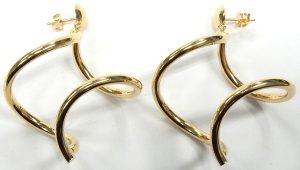 Secured with snug fitting butterfly backs on standard 0.8mm wire posts. Constructed from 2.5mm wide hollow tubing of heavy gauge contributing to a significant total weight of over 4.4 grams. These wonderful earrings are sure to get noticed and invite many compliments. Estate priced at $770.00 CAD. Stock #426-00354.
Secured with snug fitting butterfly backs on standard 0.8mm wire posts. Constructed from 2.5mm wide hollow tubing of heavy gauge contributing to a significant total weight of over 4.4 grams. These wonderful earrings are sure to get noticed and invite many compliments. Estate priced at $770.00 CAD. Stock #426-00354.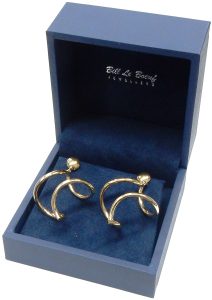
SOLD




